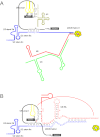Functional roles of protein splicing factors
- PMID: 22762203
- PMCID: PMC3392075
- DOI: 10.1042/BSR20120007
Functional roles of protein splicing factors
Abstract
RNA splicing is one of the fundamental processes in gene expression in eukaryotes. Splicing of pre-mRNA is catalysed by a large ribonucleoprotein complex called the spliceosome, which consists of five small nuclear RNAs and numerous protein factors. The spliceosome is a highly dynamic structure, assembled by sequential binding and release of the small nuclear RNAs and protein factors. DExD/H-box RNA helicases are required to mediate structural changes in the spliceosome at various steps in the assembly pathway and have also been implicated in the fidelity control of the splicing reaction. Other proteins also play key roles in mediating the progression of the spliceosome pathway. In this review, we discuss the functional roles of the protein factors involved in the spliceosome pathway primarily from studies in the yeast system.
Figures




Similar articles
-
Functional roles of DExD/H-box RNA helicases in Pre-mRNA splicing.J Biomed Sci. 2015 Jul 16;22(1):54. doi: 10.1186/s12929-015-0161-z. J Biomed Sci. 2015. PMID: 26173448 Free PMC article. Review.
-
The yeast PRP19 protein is not tightly associated with small nuclear RNAs, but appears to associate with the spliceosome after binding of U2 to the pre-mRNA and prior to formation of the functional spliceosome.Mol Cell Biol. 1993 Mar;13(3):1883-91. doi: 10.1128/mcb.13.3.1883-1891.1993. Mol Cell Biol. 1993. PMID: 7680101 Free PMC article.
-
Helicases involved in splicing from malaria parasite Plasmodium falciparum.Parasitol Int. 2011 Dec;60(4):335-40. doi: 10.1016/j.parint.2011.09.007. Epub 2011 Oct 1. Parasitol Int. 2011. PMID: 21996352 Review.
-
Arresting Spliceosome Intermediates at Various Stages of the Splicing Pathway.Methods Mol Biol. 2023;2666:193-211. doi: 10.1007/978-1-0716-3191-1_15. Methods Mol Biol. 2023. PMID: 37166667
-
Protein functions in pre-mRNA splicing.Curr Opin Cell Biol. 1997 Jun;9(3):320-8. doi: 10.1016/s0955-0674(97)80003-8. Curr Opin Cell Biol. 1997. PMID: 9159080 Review.
Cited by
-
Transcriptomic Analysis Provides New Insights into the Tolerance Mechanisms of Green Macroalgae Ulva prolifera to High Temperature and Light Stress.Biology (Basel). 2024 Sep 16;13(9):725. doi: 10.3390/biology13090725. Biology (Basel). 2024. PMID: 39336152 Free PMC article.
-
Mechanism of action of microRNA166 on nitric oxide in alfalfa (Medicago sativa L.) under drought stress.BMC Genomics. 2024 Mar 28;25(1):316. doi: 10.1186/s12864-024-10095-7. BMC Genomics. 2024. PMID: 38549050 Free PMC article.
-
The biological function and clinical significance of SF3B1 mutations in cancer.Biomark Res. 2020 Sep 3;8:38. doi: 10.1186/s40364-020-00220-5. eCollection 2020. Biomark Res. 2020. PMID: 32905346 Free PMC article. Review.
-
Functional roles of DExD/H-box RNA helicases in Pre-mRNA splicing.J Biomed Sci. 2015 Jul 16;22(1):54. doi: 10.1186/s12929-015-0161-z. J Biomed Sci. 2015. PMID: 26173448 Free PMC article. Review.
-
In Pursuit of Genetic Prognostic Factors and Treatment Approaches in Secondary Acute Myeloid Leukemia-A Narrative Review of Current Knowledge.J Clin Med. 2022 Jul 23;11(15):4283. doi: 10.3390/jcm11154283. J Clin Med. 2022. PMID: 35893374 Free PMC article. Review.
References
-
- Brody E., Abelson J. The ‘spliceosome’: yeast pre-messenger RNA associates with a 40S complex in a splicing-dependent reaction. Science. 1985;228:963–967. - PubMed
-
- Frendewey D., Keller W. Stepwise assembly of a pre-mRNA splicing complex requires U-snRNPs and specific intron sequences. Cell. 1985;42:355–367. - PubMed
-
- Grabowski P. J., Seiler S. R., Sharp P. A. A multicomponent complex is involved in the splicing of messenger RNA precursors. Cell. 1985;42:345–353. - PubMed
-
- Wahl M. C., Will C. L., Lührmann R. The spliceosome: design principles of a dynamic RNP machine. Cell. 2009;136:701–718. - PubMed
-
- Brow D. A. Allosteric cascade of spliceosome activation. Annu. Rev. Genet. 2002;36:333–360. - PubMed
Publication types
MeSH terms
Substances
LinkOut - more resources
Full Text Sources
Molecular Biology Databases

